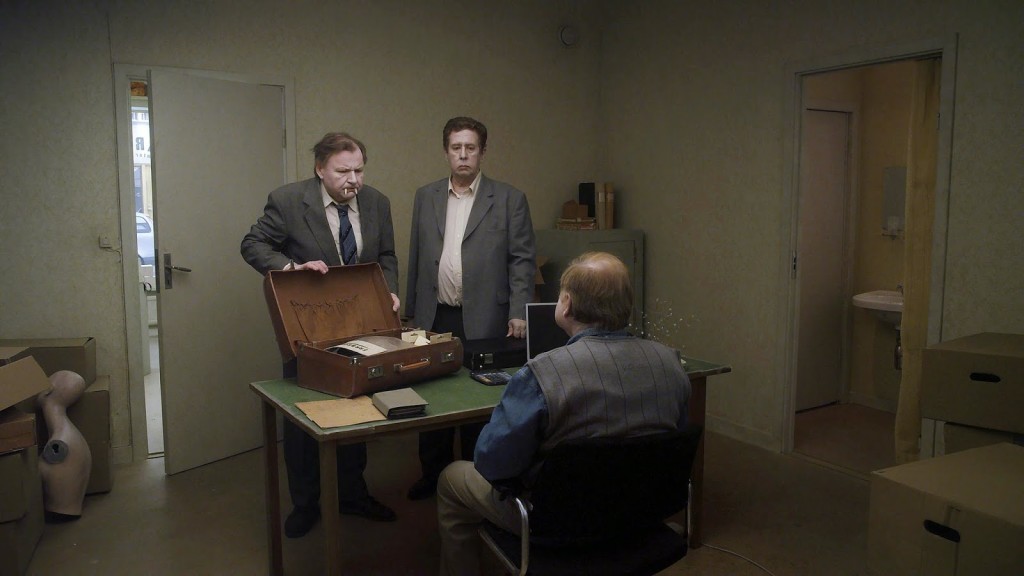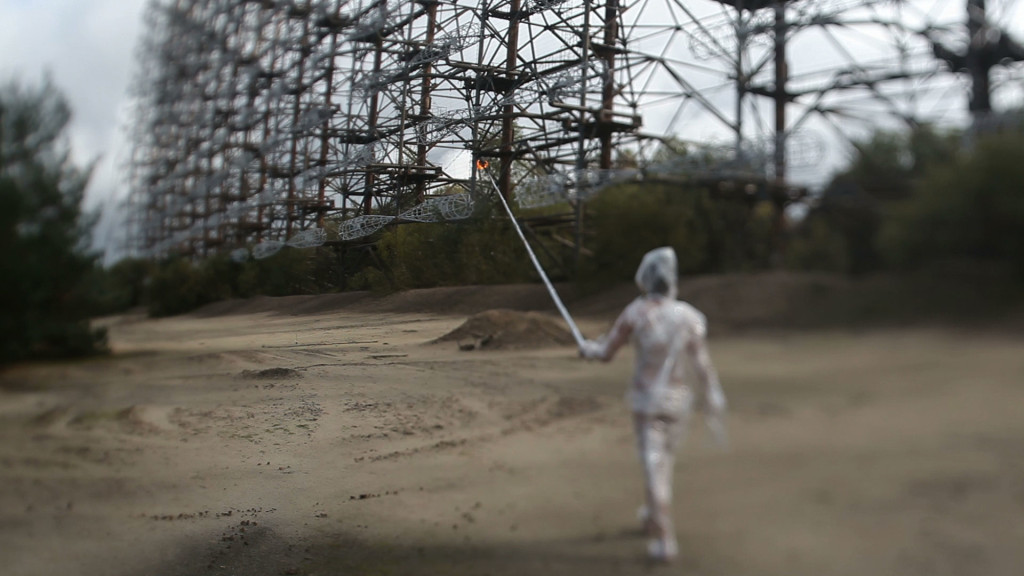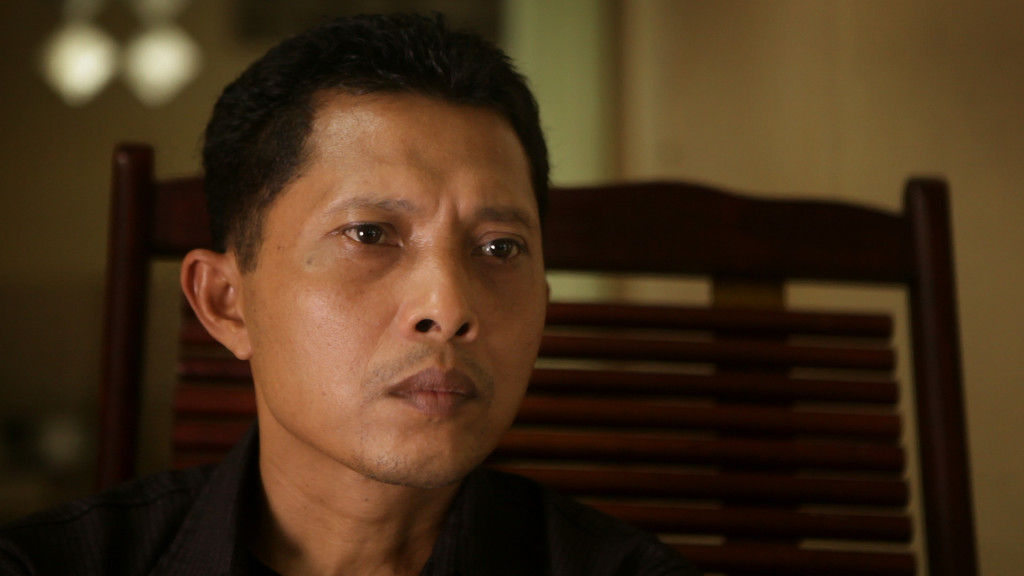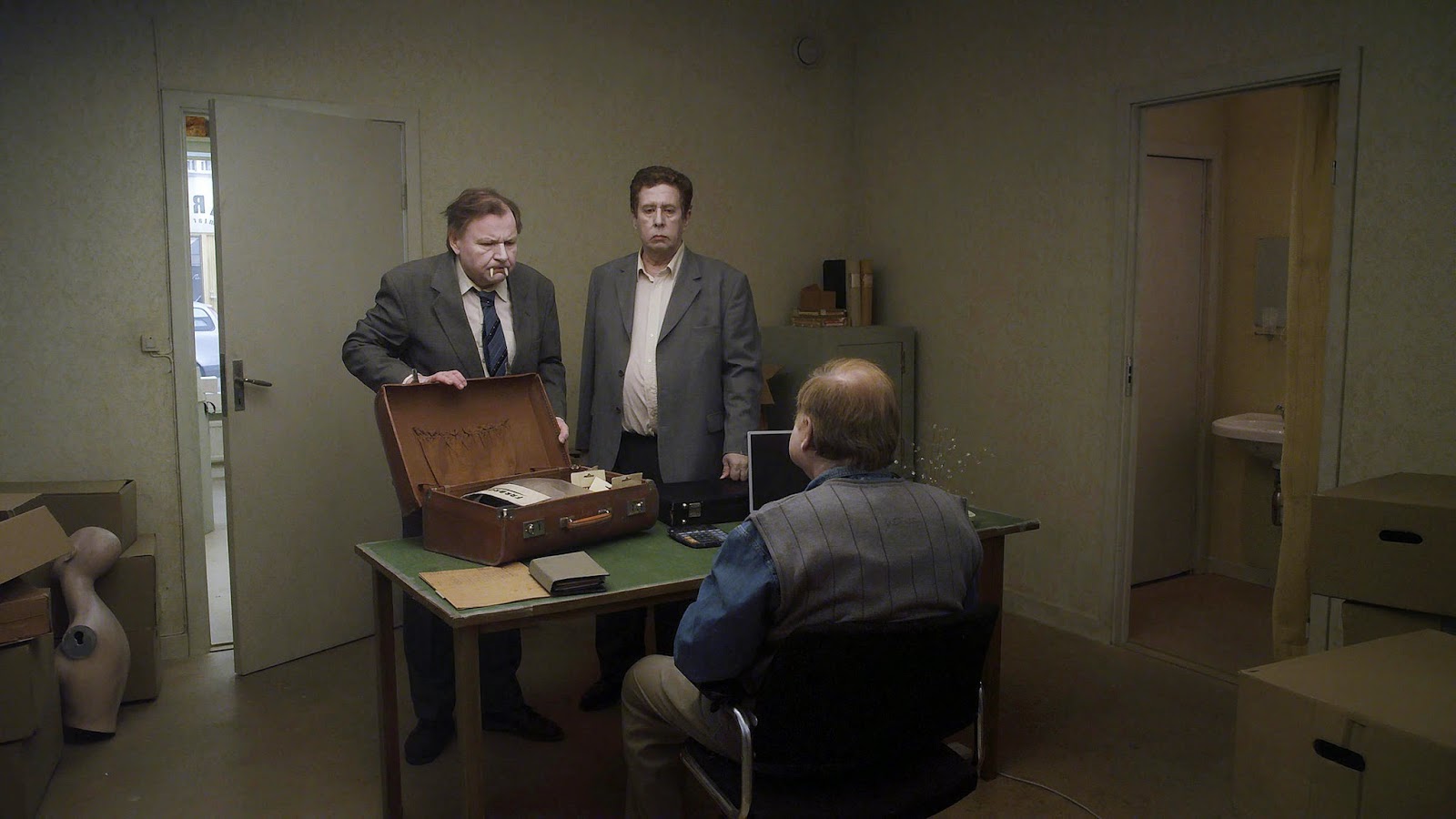
“Fun and games:” A Pigeon Sat on a Branch Reflecting on Existence – Sundance Cinema 6 (1:00-2:50p)
The finale in a trilogy “about being a human being,” writer-director Roy Andersson invites us into his timelessly surrealistic Swedish purgatory — first with a prologue involving ‘three meetings with death’ before revealing two travelling novelty salesmen at the local watering hole that was once (and maybe still possesses the ghost of) Limping Lotta’s. There’s Jonathan (Holger Andersson), the hypersensitive one, and Sam (Nils Westblom), the intolerant one, who make a regular Laurel and Hardy-like odd couple. With briefcases stocked full of extra-long-fanged vampire teeth, noise bags, and newly unveiled ‘Uncle One-Tooth’ masks, the humorless humor-vendors are led into a series of fourth wall-breaking encounters as rhetorical as they are amusing — a dance studio with an overly familiar instructor, a former seasick ship captain filling in as a barber, a police officer who continually mistakes the day/time of his meeting at a restaurant, and a grade-school student describing the titular content of her poem rather than reading it. Amidst the droll dream fragments, spontaneous and personally interpreted refrains of the nineteenth century “Battle Hymn of the Republic” break out, echo, and interconnect Andersson’s strangely staged universe in an emotionally resonant way that Friday’s Free Fall may have ultimately failed.
With the frequent use of white make-up on both prominent and peripheral characters, the line between the living and dead seems to blur. If A Pigeon Sat on a Branch is a self-professed film about living, perhaps the deadpan joke is that life can often be represented as a lifeless painting (evoking the source of the title in Pieter Bruegel the Elder’s “Hunters in the Snow”); there exists an eternal struggle to remain animated or motivated despite the horrors of human history. It’s a bleak contemplation that is lightly addressed as characters repeat themselves ad nauseam (the cell phone catch-phrase, “I’m happy to hear you’re doing fine”) and Sam’s mockery of Jonathan’s zombie-like movements. But, at its more profoundly abrasive later in the film, Andersson digs into more philosophical and condemnative territory, and the results are as hilarious as they are potentially alienating. Following an ostentatiously pompous entrance by an all-male army of war reenactors (or perhaps actual eighteenth century combatants) following the lead of Charles XII, they assume control of a modern seaside bar and terrorize the orderly community on horseback. A ‘homo sapiens’ epilogue lets loose its vitriol on our species but not before concluding with a most banal scene that seems to reflect upon the film’s quiet, punctuating moments of modest miracles — two girls blowing bubbles on a balcony, a mother comforting her baby, a couple gazing at the dawn out their apartment window.

“Tapping ghosts:” The Russian Woodpecker / Winterlude – Sundance Cinema 1 (4:15-5:50p)
The Look of Silence may be the WFF documentary selection with the official Werner Herzog connection, but his sensibility is felt in UW-Madison graduate Chad Gracia’s Russian Woodpecker. Concerning pacifistic performance artist Fedor Alexandrovich’s journey from the Ukraine to Russia to uncover the truth behind the 1986 Chernobyl disaster that plagues the region to this day, the film is a descent into the spectral supremacy of the Soviet Union that still looms even after its dissolution at the end of 1991. Through several rounds of interviews with various government officials captured on hidden cameras, a pattern and conspiratorial connection emerges between the Chernobyl nuclear plant and the Duga-3, an exorbitantly costly radio transmitter nearby that began emitting low frequency sound wave ‘tapping’ across the world in 1976. Eventually, through diligent archival research, Fedor begins linking names of Duga officials together with certain dates preceding the Chernobyl “accident,” illustrating them in real-time on a mirror with erasable marker. The discovery is enraging for both audience and subject; however, the energy that follows this remarkable revelation is harnessed and presented in a most creative means.
For a such a convoluted situation, Gracia and company keep their eyes on the personality that is Fedor — his courageousness, his fears, his humanity. From his initial appearance at a theatre design workshop to a rousing speech at a protest rally in Kiev, the tone is clearly intertwined with Fedor’s mentality. On occasion, the attempt to contextualize political developments with mostly American archival news footage distracts from cinematographer Artem Ryzhykov’s keen eye. In fact, one of the film’s most chilling moments is not in the reveal of the few names most directly responsible for what Fedor begins to classify as the Chernobyl “genocide,” but a visit to a ruined ‘Sport and Culture Palace.’ Strewn throughout this massive, crumbling structure are useless gas masks issued after the radiation leak that provided no protection. With a partially unfocused lens that instills the scene with a haunting aura, Fedor wraps himself in plastic like a mummy performing a ritual to honor the dead in his own tomb, waves a lit torch, and creeps across the gas masks littering the stone floor as if they were skulls of the deceased.
*Also, let’s not neglect the preceding beauty of Winterlude by UW-Milwaukee’s Gregory Bishop. A perfect visual companion to Jonathan Glazer’s Under the Skin (2013), Bishop’s experimental short film emotionally prepares the audience in a palette of anxious reds and abyssal blacks for the impending blanket of doubt cast in Gracia’s full-length feature.

“Deep questions:” The Look of Silence – Sundance Cinema 6 (8:15-10:00p)
As the title implies, Joshua Oppenheimer’s The Look of Silence, a continuing of the events detailed in its inseparable companion, The Act of Killing (2012), is about perception. And like its predecessor, Oppenheimer and a largely anonymous crew (including a co-director) layer the film with a most interesting thematic concept. Adi, an optometrist whose brother Ramli was imprisoned and executed before he was even born, visits the perpetrators or those implicit in crimes against humanity, to perform eye exams and fit them for bifocals all while helping them figuratively see the savageness of the past by initiating a magnifying conversation about the military control of Indonesia and their own groups (Komando Aksi) responsible for executing suspected communists.
The film is as much of a personal investigation as it is national one. Despite Adi’s best efforts to hold a looking glass up to the faces of the leaders of execution mobs and wash away the propaganda ingrained with military allegiance, he’s met with resistance at every turn that occasionally reveals a forced amnesia and infectious madness — a vampiric dimension to superstition that goes beyond all reason and fathomable horror. (At one point in conversation with a death squad leader named Inong, a high-pitched noise pierces the soundtrack and continues to ring like a country’s case of tinnitus contained in George Santayana’s quote, “Those who cannot remember the past are condemned to repeat it”). There’s no talk of the imitation of Hollywood movie violence and gangsters like there was in The Act of Killing, but it isn’t necessary to comprehending the victims here. Instead, a perturbing silence and gaze of disbelief replaces the occasional theatricality of this film’s companion. Adi’s anger is always tempered to fuel some greater, altruistic purpose and his belief in spiritual awakening. While scenes with his daughter, Aisyah, feel tonally separate from the confrontational brutality of the ongoing investigation, they demonstrate a life beyond oppression and immense tragedy that saw over one million native people perish.

